GOOD ROADS





Design and engineering are at the heart of Volkert’s practice.
We are celebrating a century of providing clients with quality solutions for safe and efficient mobility and for a sustainable environment.
ROAD + HIGHWAY SERVICES
BRIDGE + STRUCTURE SERVICES
ENVIRONMENTAL STUDIES + PERMITTING
TRANSPORTATION PLANNING
TRAFFIC ENGINEERING
COMPLETE STREETS + BIKE/PEDESTRIAN
COASTAL RESILIENCY
WATER RESOURCES

Louisiana’s Lake Pontchartrain Causeway
Northbound span (1969)
Emergency shoulders (2020)
From
New ARDOT Director Understands ARDOT Culture While Preparing for Future Challenges
30 Crossing: What Went Right?
Good Roads Members Take Pride in Historic 30 Crossing Project

Good Roads Member Kiewit Infrastructure South Co. Selected for Interstate 55 Bridge Replacement Project
Alternative Delivery Methods— Building Better Roads
Transportation Connections: People, Projects, Promotions
Side Roads
Delta Companies Inc. Announces Rebranding, Regional Consolidation Under Delta Name Longtime Good Roads Member Matt Crafton Named to ACEC College of Fellows ARDOT Selected to Receive $24.9 Million Federal RAISE Grant for Corning Bypass
Governor Sanders Appoints Jerry Halsey to Arkansas State Highway Commission





Robert Moery President
Lance Lamberth Vice President
D.B. Hill, III Secretary/Treasurer
Harold Beaver
Graycen Bigger
JoAnne Bush
Bob Crafton
George Cress
Curt Green
Mark Hayes
Jerry Holder
Shannon Newton
Philip Taldo
Chris Villines
Jim Wooten
The Arkansas Good Roads/Transportation Council was established in 1975 as a 501(c)(3) non-profit, tax-exempt and tax-deductible organization. In 2015, the council was re-established as a foundation in order to be a more visible and credible voice on behalf of the mission of the Arkansas Highway Commission and the Arkansas Department of Transportation. The purpose of the foundation is to promote adequate funding and financing for the planning, development, construction, and maintenance of a safe and efficient highway, street, road, and bridge system, including transportation enhancements. The work increases statewide economic growth, private sector job creation and retention, and improves the quality of life in all Arkansas counties, municipalities, and communities.
Joe Quinn, Executive Director goodroadsfoundation@gmail.com
Kathryn Tennison, Editor kathryn@bestmanagement.net
Celia Blasier, Designer graphics@bestmanagement.net









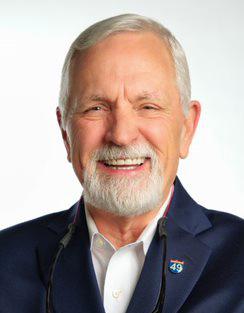



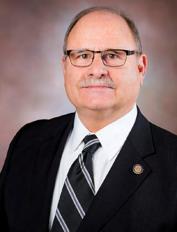



There is so much discussion in our country about how government should work. Each day brings angry digital posts about government waste and agencies that some feel are long overdue for budget cuts. I thought about that anger on a recent Wednesday morning as the Arkansas Highway Commission convened for a meeting at ARDOT headquarters in Little Rock. People tend to arrive early and mingle around the room, drinking weak coffee laid out on a small table. The faces are familiar. The infrastructure community in Arkansas is a cordial group that has interacted for decades.
There is a protocol to these meetings; there is also civility. People who attend often dress in an old-school manner. The men are still in suits and ties, the women in dresses. This is not a gathering of raised voices and people demanding to speak. There is a sign-in sheet for any public member who wants to say a few words, and there has never been a debate over whether that is appropriate.
There was a time when anyone would have expected a meeting like this to be civil, but that’s not always the case in government in 2025. Perhaps the lack of anger and division is precisely what sets this meeting and culture apart.
On this day the meeting is different. Change is in the air. Highway Commissioner Philip Taldo is taking over as Chairman of the Commission today. The longstanding protocol is that each commissioner serves as chair during their final year on the commission. Jared Wiley is sitting at the end of the table in his first meeting as ARDOT Director. Wiley grew up in the system at ARDOT. He is thoughtful, soft-spoken, and fully engaged when he speaks with anyone. He will continue the tradition of ARDOT having respectful relationships with contractors and community leaders.
The third new face in a new seat is Jerry Halsey of Jonesboro, appointed to the highway commission
by Governor Sarah Huckabee Sanders. The chairs may have been rearranged today, but the flow of the meeting is unchanged. The faces change, but the work gets done: older roads get repaired, bridges get inspected, major new projects get funded, and the effort continues to keep the commission’s work nonpolitical.
In this issue of our magazine, you will read about the largest road construction project in Arkansas history. Many things worked flawlessly as 30 Crossing improved the roads and interchanges at the heart of Little Rock. It was under budget and ahead of schedule, which means it didn’t get much news coverage, but ultimately, the department will try to use the lessons from the effort in future projects.
You will also find in these pages a profile of Jared Wiley written by Deborah Horn. What’s apparent is that, before all else, Wiley is a devoted family guy who understands both Arkansas culture and the direction he wants ARDOT to take in the years ahead. His transition into the new role has been quietly seamless. It’s an understatement to say everyone involved is pleased.
And finally, in the months ahead, we will tell you about the dedication of the new Fallen Workers Memorial on ARDOT property. This would not have been possible without the donations our members made in terms of both funding and donated labor and materials. A profound thank-you to those of you who helped get us to where we are today. The money has been raised, a contractor has been identified, and construction should be underway by the time you read this.
As always, thank you for supporting our efforts. Please put your cell phone down when you drive through work zones.

July 24-25,
Hot Springs, Arkansas
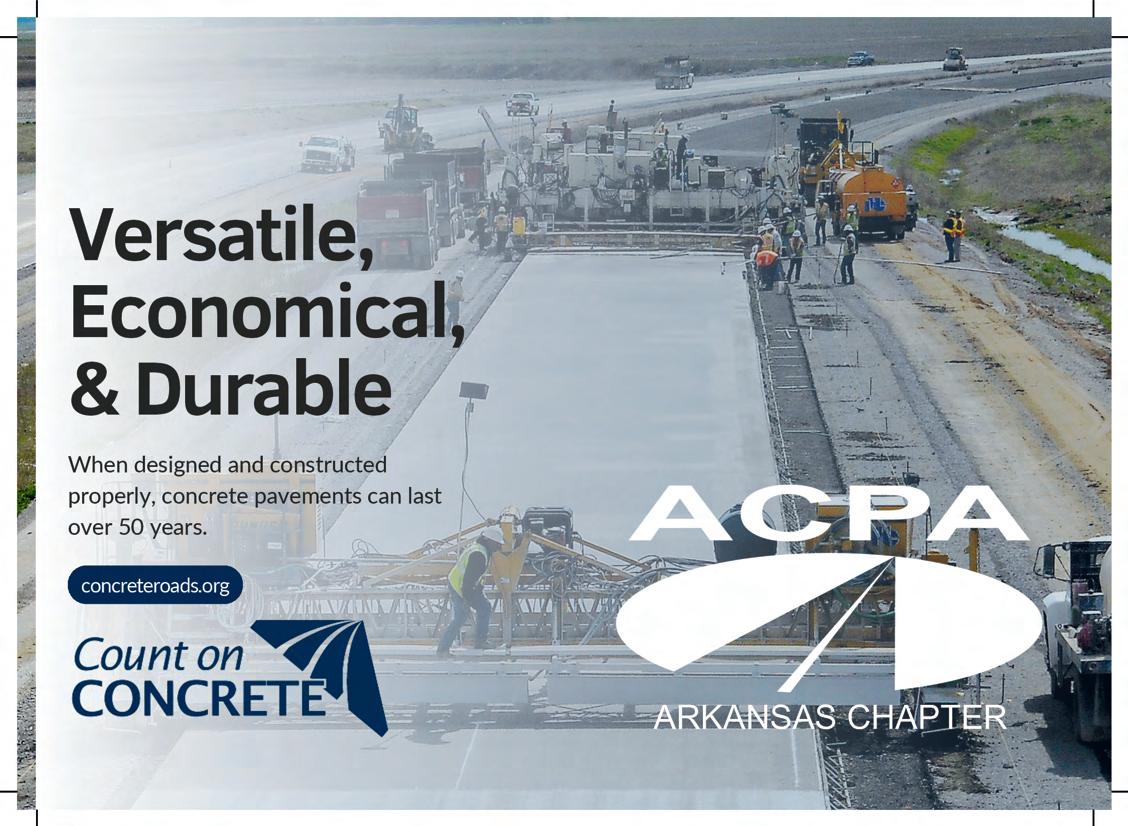


By Deborah Horn
Walk into Jared D. Wiley’s office, and it’s clear he values his family and Arkansas’s natural offerings. The wall opposite his large north-facing window is covered with eye-catching photos taken in natural settings like the Arkansas Little Grand Canyon, Cane Creek, and Bird Island, and many contain images of his wife and children exploring the landscape. Wiley quickly pointed out, “We did the 52 Arkansas State Parks Challenge, and I think we hit the right sweet spot, age-wise, with our four kids. They were great and willing participants. We camped at most places, and we really enjoyed the journey. We finished it last year.”

Jared D. Wiley grew up in Malvern and was the son of educators. His father was a physics major and could have worked in Houston during the oil boom time but decided to stay home. Because of that, Wiley said, “I had a fantastic upbringing. We grew up hunting and fishing.” Preserving the natural state is one of his passions. He was named ARDOT Director late last year and formally stepped into the position on Jan. 11.
They are now members of State Parks Club 52, and as such, he has firsthand knowledge of the state’s natural diversity and how it impacts the people who live there.
Ten days after the start of the new year, Arkansas Department of Transportation (ARDOT) Director
Lorie Tudor retired, and the following day, Jan. 11, Wiley stepped into the top spot. As he moves forward, Wiley’s interest in bettering the state extends beyond his family to building a legacy that leaves all Arkansans with a brighter and more economically secure future.
It’s been a fast-paced few months, Wiley recalled, sitting in his 10thfloor office a few weeks ago. He now oversees the state’s third-largest department—its 2024 operating budget was about $953 million—and about 3,900 employees spread out over 75 counties.
It’s also the state’s largest employer of civil engineers. Additionally, his job started about the same time as the 2025 Arkansas Legislative Session.
Legislative outreach is essential, and a session was recently held at ARDOT headquarters on Interstate 30. Wiley said, “We discussed the department’s history, its structure, and how decisions are reached. We showcased our staff and our equipment. We discussed
the need for long-term program stability and open communication between ARDOT and legislators.”
Long before visiting the state’s parks, Wiley worked with ARDOT’s 11 regional districts and talked with public and private entities about their varied transportation needs. Those of the rural areas, heavy with farming, are often vastly different from urban areas, heavy with traffic. Even within the agricultural communities, the transportation needs of the hilly and mountainous areas of the state’s western half differ from those of the Delta. The state’s interstates, which often intersect with busy highways and city streets, present their own challenges.
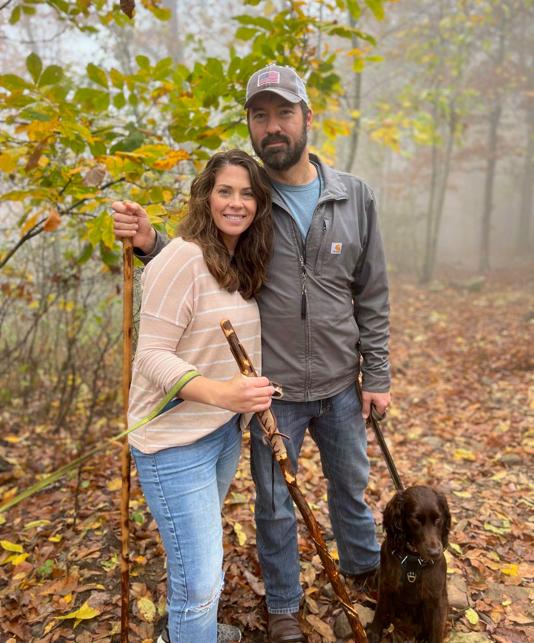
Jared Wiley and his wife, Jessica, at Queen Wilhelmina State Park near Mena. Wiley’s wife and four kids completed the 52 Arkansas State Parks Challenge last year
“We must be able to meet the varied demands of all the state’s areas. It must be our focus,” Wiley said recently while sitting in his office. But it’s not a simple task, he countered.
“We have 16,000 miles of highway to take care of. Our system is large, larger (roadway transportation system) than California’s,” Wiley said. He added, “We’re the 12th largest highway system in the country, but we are not the 12th largest in revenues.” Historically, ARDOT was severely underfunded, and Wiley said, “Back then, we were doing the best with what we had.”
But that changed with the passage of a 1/2-cent sales tax by 58 percent of the voters in 2012. This tax was then made permanent, also approved by the voters, in 2020. Additional Arkansas Legislative and federal monies helped alleviate ARDOT’s ongoing funding crunch. Today, Wiley said the department
is better financially positioned to meet the state’s transportation requirements. ARDOT is able to maintain its highways through what’s called their Preservation Program and has allotted $300 million to it.
About $100 million is earmarked for interstate work and another $115 million for bridges. Wiley added, “It’s critical that we take care of what we have,” but as demand dictates, new highways or interstates may be built in the future. He believes ARDOT must remain good stewards of the taxpayers’ funding as evidenced by the on-time, on-budget completion of the recent Interstate Rehabilitation (IRP) and Connecting Arkansas (CAP) programs, as well as the early completion of the I-30 bridge and interstate widening project, dubbed 30 Crossing.
“We’ve been faced with some historic inflation that started with COVID-19, but we hope that’s at least plateaued…It’s hard to go anywhere in Arkansas these days and not see fresh asphalt,” Wiley said.
Keith Gibson, AHC member, said, “There were many qualified candidates, but Jared’s knowledge and the respect he’s earned as a professional set him apart.” In addition to assuming a role as liaison between ARDOT and members of the Arkansas Legislature and Gov. Sarah Sanders, Wiley will work closely with AHC members. Gibson added, “Jared has the skill and ability to work well with others,” and he believes Wiley has what it takes to have “a long and distinguished career ahead of him at ARDOT.”
Wiley said he follows in the footsteps of great
ARDOT Directors, and “each left their mark.” For example, Dan Flowers brought the department into the modern era, while a few years later, Scott Bennett focused on integrating early technology, such as computers, software, and email, into their roadway designs and contractor bid processes. Director Tudor restructured ARDOT’s departments and districts, focusing on employee-and-partner building and onthe-job safety. She also embraced and utilized the latest technologies, many of which reach beyond the office and into the field. Two recent examples include the installation of Wrong-Way Detection Systems on several of the state’s interstate off-ramps around Central Arkansas; and Drivewyze, an in-cab traffic management and alert system designed to increase driver safety.
Marie Holder, AHC member, said, “Jared Wiley has the commission’s full support to serve as ARDOT Director. He produced excellent results as Chief Engineer for Pre-construction and he strives for excellence in everything he undertakes. He holds himself accountable for his actions and is responsible
and transparent in his role. We are grateful for his service and thrilled to support him in this new role.”
About 20 years ago, when Wiley first signed on with ARDOT, the engineering design process of handdrawn and calculated blueprints started shifting from paper to computers. Nowadays, a design project often incorporates lidar imaging, drones, maps, real-world photos, and more to create it. This helps predict or minimize problems before construction begins. Wiley said, “Also, we can go to the public or a contractor and, instead of showing them two-dimensional flat plans on paper or an aerial photo, show them a video of what it’s going to look like when it’s built.”
Keith Gibson, an Arkansas Highway Commission member, said it’s impossible to predict the impact AI and other technologies currently under development will have on road design and construction. Gibson added, “It will be a key going forward,” and Wiley agreed.
“It’s hard to see around the next corner,” but

Wiley feels he and his staff must be ready for whatever comes over the next few years. He added, “Technology is rapidly changing, and we’re doing our best to encourage our staff to educate themselves on the latest innovations…It’s going to transform the workplace.” He plans to grow the department’s use of the latest technology, whether in design or creating safe roadways for the traveling public, ARDOT employees, and their contractors—who call Arkansas roadways their workspace. Holder believes Wiley has the skills and understanding to implement the new technologies.
The new Director feels the development of this and the next generation of employees is as vital to the department’s long-term success as technology. Wiley said, “We encourage our staff to learn, and we offer continuing education through internal programs we offer. We have to be ready. I believe AI is going to transform our industry. So, it’s critical we keep up.”
Already ARDOT is talking about what it will take to make that shift.
As a college engineering student doing a summer internship in Hot Springs, Wiley said ARDOT
personnel made a lasting impression on him, adding, “I started as an end-time student and did three summers, and I loved what I saw here—the culture, a shared sense of service, and the goal of shaping a brighter future for our state. That’s why I chose to take a job here when I graduated.”
Wiley graduated Cum Laude from Arkansas State University (ASU) in Jonesboro with a Bachelor of Science degree in engineering with an emphasis in civil engineering in 2005, and was offered a job in ARDOT’s Planning and Research Division. Wiley recalled, “It was a good fit.” While in the department’s Planning Branch in Little Rock, he oversaw traffic count and roadway inventory programs. He advanced until he was promoted to Consultant Coordinator in the office of the Deputy Director and Chief Engineer in 2013, and the following year, he was promoted to Assistant Division Head of the Transportation Planning and Policy Division.
About 16 months later, he became the division head of program management, and in 2020, he was named Assistant Chief Engineer for Planning under Tudor. In April 2023, he was promoted to Chief Engineer for Pre-construction, a role he held until he was appointed Director. Wiley has about two decades of experience

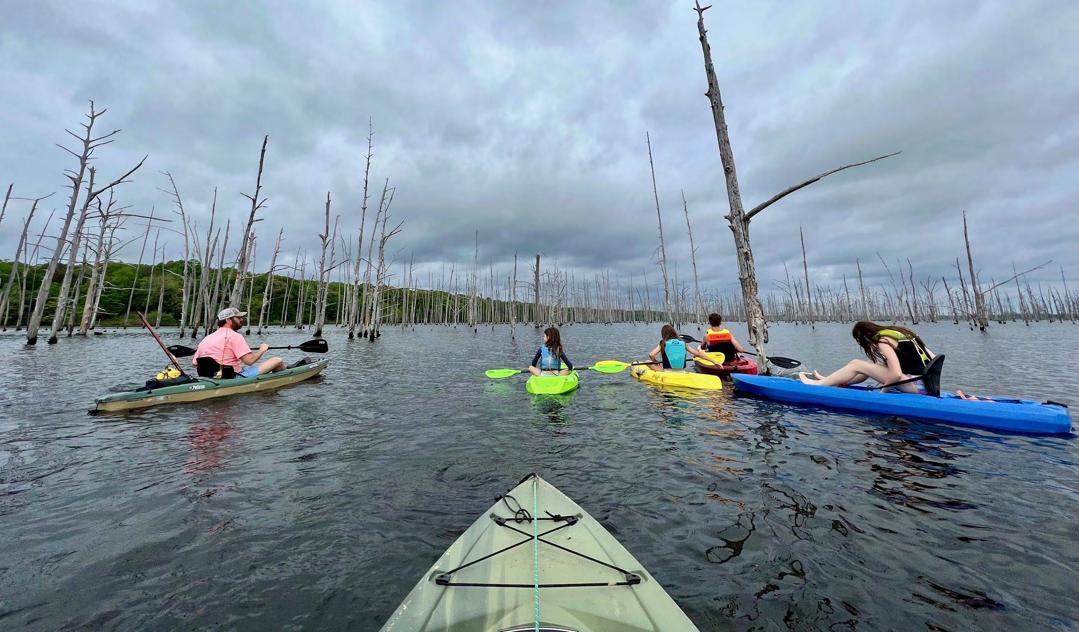
in transportation planning and programming, project management, and leadership. He said he’s “passionate about leading teams, streamlining processes, and delivering quality.”
Wiley is a Registered Professional Engineer and an active member of A-State’s College of Engineering and Computer Science Alumni Academy. He was awarded the Director’s Diamond Arkansas Department of Transportation Award in 2019, and in 2022, he was named Transportation Vanguard Award Nominee by the American Association of State Highway and Transportation Officials (AASHTO).
The same year, ASU’s College of Engineering and Computer Science named him an Alumni Academy Member. He is also a member of AASHTO and is involved in funding and finance, active transportation, and planning committees.
Wiley and his wife, Jessica, live near Benton and have four children and three dogs. He enjoys outdoor activities with his family such as hunting, fishing, and camping. He is also an avid collector of lapel pins and grows ficus trees.
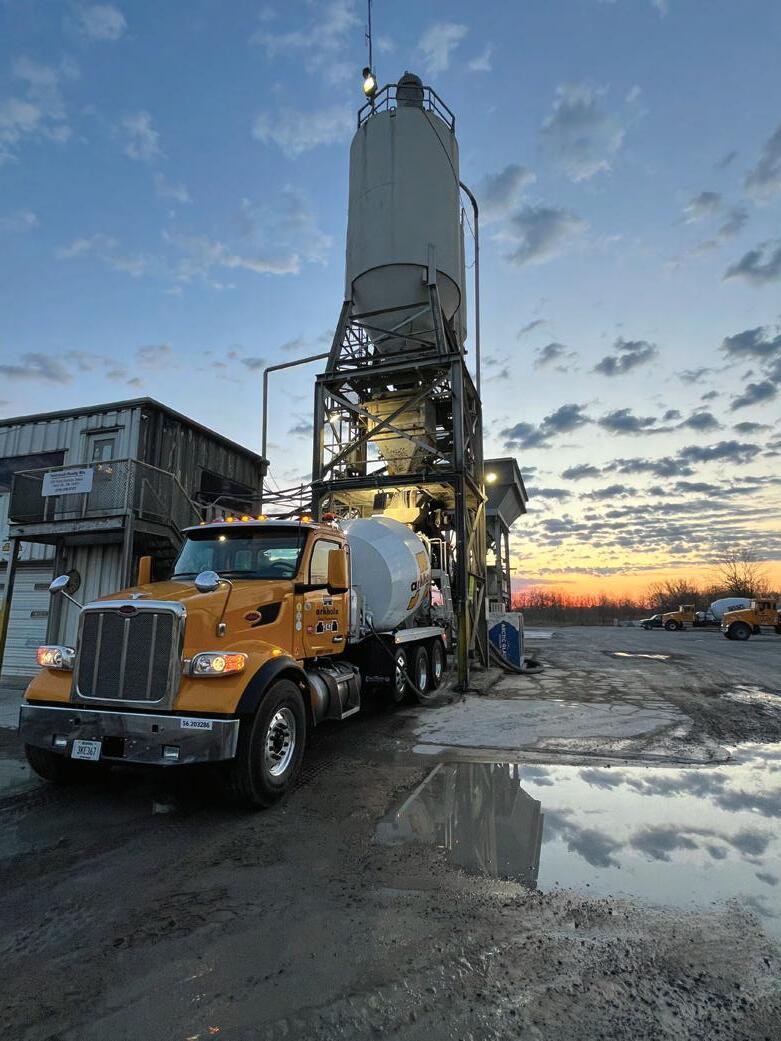

By Deborah Horn
Rewind two years, and the roadway construction on Interstate 30 through downtown North Little Rock and Little Rock appeared chaotic. However, upon further inspection, meticulous calculations and methods were behind the largest, most expensive road construction project ever undertaken by the Arkansas Department of Transportation (ARDOT). It was named 30 Crossing.
The project was to rebuild 4.7 miles of the multilane interstate that runs through downtown Little Rock and North Little Rock from I-40 to the north and I-630 to the south and multiple interchanges. It replaced the 68-year-old, six-lane bridge that spanned
the Arkansas River between the two cities with a modern 12-lane bridge that dealt with today’s heavier traffic demands.
According to then ARDOT Director Lorie Tudor, the goals were to widen I-30, the number of lanes of which varies depending on the location along the route, improve access ramps, reduce the interstate’s footprint in the downtown area, and reduce travel times and rush hour congestion in and around the city. The 30 Crossing rebuild cost about $633 million.
Traffic flow was a top priority throughout construction. ARDOT required all existing lanes on I-30 to remain open, so the team carefully
planned construction phasing and work zones to minimize disruptions. Cass Sobek, Kiewit-Massman Construction (KMC) Project Manager, said, “Our ARDOT-KMC team shifted the alignment of the new eastbound Arkansas River bridge slightly east— allowing the eastbound bridge to be constructed in a single phase—which limited lane reconfigurations.”
The team also took advantage of the Design-Build construction system’s flexibility. Sobek said, “If we noticed backups at a certain on-ramp or street, we could quickly adjust lanes, signals, or timing. This approach’s ability to modify traffic control in real time was a major advantage.”
For example, Keli Wylie, ARDOT Assistant Chief Engineer-Program Delivery, added that the project’s scope initially did not include the reconstruction of the I-30 to I-630 bridge, but it was revised in 2022. “Design-Build, like any alternative delivery method, places a high emphasis on collaboration. By having a single contract for the construction and design of a project, the design-builder has more control over risk and innovation, often leading to expedited project delivery. Typically, projects with a complex design with many stakeholders and high-risk activities are well-suited for Design-Build.”
In November 2024, 30 Crossing was completed ahead of schedule. Wylie said, “I had high confidence that the project would finish on time, but was pleasantly surprised that we finished seven months early.”
Wylie says there are reasons the complex project went smoothly: “KMC consistently exceeded their estimated completion date due to efficient scheduling and execution of work. The schedule certainty was always high because of how KMC identified and scheduled work activities. We started hearing about early completion around early 2024 solely based on the remaining construction activities in the schedule. Still, we also knew that some of the work near the end of 2024 was temperature dependent.”
A View from Downtown
Downtown resident Don Copeland said the work caused some adjustments in his usual travels, but he kept up with the street and bridge closures and adapted his schedule to avoid high-traffic times. “I didn’t encounter any major traffic jams, only the occasional minor delay.”
Hector Cardona of Little Rock traveled I-30 in the afternoon Monday through Friday and adopted a mantra of patience. He said, “It was interesting to watch the construction’s progress. The work caused the traffic flow to slow for a few months, especially around Sixth and Ninth streets.”
Terri Roberts of North Little Rock has clients in downtown Little Rock. For the duration of the construction, she avoided I-30 and traveled to Main Street instead. She was delighted when she found out the work was complete, saying, “The interstate is so much easier to navigate than before, even during heavy traffic times.”
Initially, former journalist and 20-year downtown resident John Hofheimer was concerned about the work’s scope and impact and wondered if there was another option other than a significant rebuild. Over time, he changed his mind. “There were few interruptions as the work progressed, and now on and off access to and travel on the interstate is much easier and safer.”
Wylie previously oversaw the $2 billion Connecting Arkansas Program (CAP). In early 2019, she was named Project Director of 30 Crossing and Administrator of the Alternative Project Delivery Program.
Her list of job responsibilities on 30 Crossing wouldn’t prove easy. Some downtown residents did not welcome 30 Crossing with open arms. In the project’s early days, public hearings were held to explain the process and the work and allow the public to voice their concerns; Wylie said, “I was

yelled at, but I think it was coming from a place of frustration.”
She didn’t dismiss the public but took their concerns seriously. ARDOT continues to increase the number of public hearings on all projects as part of a more significant overall effort to listen to community and individual concerns.
The 30 Crossing Project was ARDOT’s first-of-itskind venture. The department used the Design-Build approach instead of relying on the traditional “design, bid, and build” technique. Basically, the designer, contractor, and sometimes the owner (ARDOT in this case) collaborate as a team from the earliest phase to completion, ensuring the project remains on schedule and budget.
When it was decided that the job needed to reconstruct I-30 from I-40 to just beyond I-630, this delivery approach lent itself to a redesign or add-on. The new approach to large projects means more flexibility as needs change. It was paramount that ARDOT find a company with the expertise to handle this type of proj-
ect on several levels, from design, organization, and a competent workforce to construction and dealing with the unexpected and more.
The Arkansas State Highway Commission approved the selection of KMC as the design-builder for the 30 Crossing project in early January 2019. That was about two years after submitting a Request for Qualifications and a Request for Proposals, which included detailed information about design, construction methods, third-party coordination, and an optimization and refinement plan. Six DesignBuild teams responded by June 2017. The KMC team included lead designer Burns & McDonnell Engineering of Kansas City, Mo., and Volkert Inc. of Mobile, Ala., a quality assurance firm.
“I was the main point of contact,” said Wylie, so her day started with updates and coordination with the design-construction team. She added, “This led to quicker problem-solving, greater innovation, and efficient project delivery…KMC handled the job perfectly.”
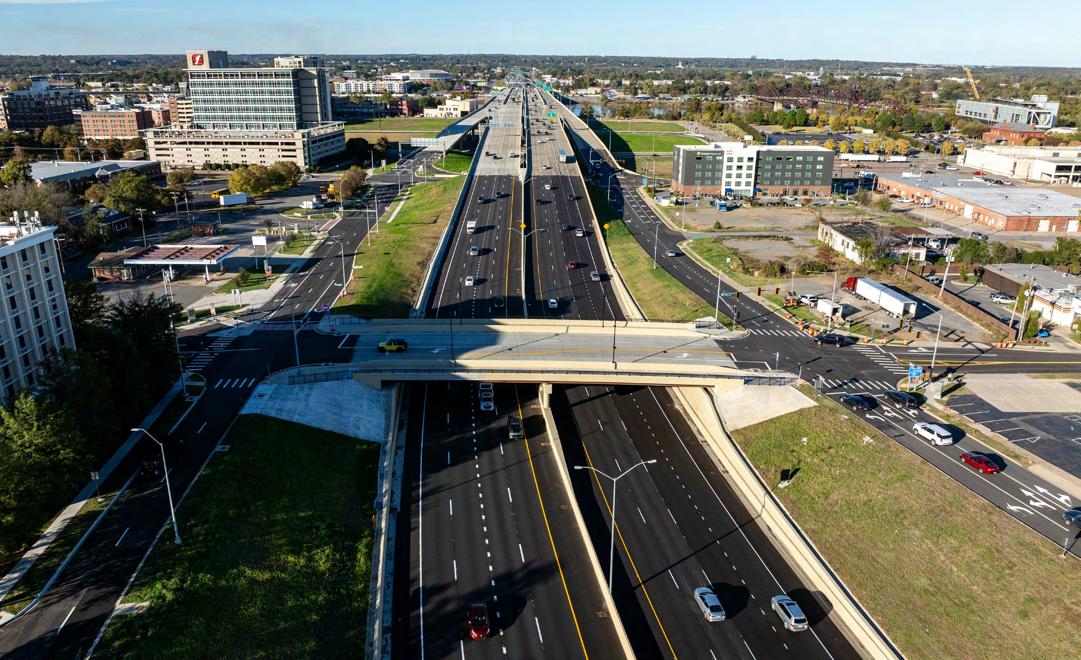
Cranford Construction Co. of North Little Rock subcontracted with KMC on 30 Crossing. Guy Washburn, PE, the company’s General Manager, who has 20-plus years in highway construction, said, “We sold the job as a furnish and install, and we were a subcontractor on milling and paving.”
He described it as a focused and intense few years and added that KMC had the expertise to tackle a job like 30 Crossing. Washburn said communication, the approach, and maintaining an organized and on-time schedule were essential to its outcome. He described the job as massive but “well thought out, organized, and extremely schedule driven. Everyone involved had regular progress meetings, and we talked about the two weeks ahead. In some cases, the next 30 days.”

The job was divided into blocks, and Washburn likened the project’s block construction approach to the vertical construction of a multi-story building. The blocks were numbered, and “we might have worked in block 28 this week, then shifted to block 15 or 16.”
This allowed Cranford staff to plan and get personnel, materials, and equipment in place, which was critical because much of Cranford’s work was done after daylight hours. Washburn said, “It’s extremely dangerous to work at night. There’s only a few feet between us and the traffic. Drivers speed through the work zones, and there are drunk drivers. It’s more difficult for drivers to see at night, and people get sleepy.” Safety was “everyone’s top priority.”
Washburn says that completing the project early led to favorable news coverage, but for him, it was personal: “It took a lot of planning…Many people are stepping up, seeing it through to the end to make 30 Crossing happen, and I’m proud of Cranford’s role. All our guys, including myself, feel a deep sense of pride in the job.”
Professionally, 30 Crossing consumed a majority of Wylie’s time and focus over the past 10 years from the requirements of the National Environmental Policy Act (NEPA), the development of the DesignBuild process for ARDOT, working through project development, the bid process, to overseeing the construction that moved along smoothly and with few issues.
“It’s extremely dangerous to work at night. There’s only a few feet between us and the traffic. Drivers speed through the work zones, and there are drunk drivers. It’s more difficult for drivers to see at night, and people get sleepy.” Safety was “everyone’s top priority.”
— Guy Washburn, PE, General Manager, Cranford Construction Co.
Wylie said, “I’m very proud of the project team involved with 30 Crossing, especially Mark Trickey and Scott Eldridge. Their experience and knowledge set the tone during construction, and we were able to make quick decisions in the field and keep the project on track. A few of us have been involved since early 2014, so to see this project completed, and early at that, is pretty incredible. There is a tremendous sense of pride to be involved in a project of this magnitude and importance to the state.”

Cass Sobek, Kiewit-Massman Construction’s 30 Crossing Project Manager, recently reflected on what went right on 30 Crossing. “Careful planning and adaptability allowed the team to meet and beat the project schedule. The first major milestone, set in May of 2020, was opening the eastbound river bridge by Sept. 1, 2022,” Sobek said.
That momentum carried through to the most complex part of the project, the I-30/I-630 Direct Connector. By double-shifting key operations and applying lessons learned from earlier phases, the team delivered the project seven months ahead of schedule despite challenges such as 18 feet of rain and snow during construction.
The project relied on more than 70 subcontractors, each integrated into the schedule. Whether handling
asphalt paving, specialized earthwork, or nighttime steel demolition, every subcontractor contributed to keeping the project on time and minimizing disruptions. Sobek said, “A truck spilled chicken parts all over the road, not in the usual construction plan, but it showed our ability to adapt quickly.”
Beyond unexpected events, the project team proactively accounted for seasonal challenges. High water levels in the Arkansas River traditionally rise for four to six weeks every May, making water-based work impossible. By anticipating these seasonal shifts, the team planned around them to stay on track.
From day one, safety was No. 1 on the 30 Crossing project. Kiewit-Massman Construction and its partners operated under the Nobody Gets Hurt safety philosophy, ensuring every worker, motorist,
and community member remained protected throughout construction.
Sobek emphasized, “Nothing is more important than safety. We built this project with the mindset that every person on-site should go home the way they arrived. That meant rigorous safety planning, daily site evaluations, and coordination with ARDOT to keep our team and the traveling public safe.”
“Because all partners were invested in a unified goal, decision-making was more streamlined. This led to quicker challenge resolutions and more efficient progress on critical project milestones.”
— Cass Sobek, Kiewit-Massman Construction’s 30 Crossing Project Manager
This commitment extended beyond the construction team. With live traffic running alongside active work zones, the project team meticulously planned temporary barriers, traffic shifts, and night work operations to minimize risks while maintaining traffic flow.
According to Sobek, “early and ongoing integration” was one key aspect of tackling such a massive, multifaceted job. “One of the most significant contributors to 30 Crossing’s success was the intense focus on team integration from day one. ARDOT, Burns & McDonnell, HDR, Garver, and construction partners established a shared vision for the project. By aligning goals early, each stakeholder understood how design, right-of-way acquisition, utility relocations, and construction phases fit together. This holistic view helped prevent the inefficiencies and communication gaps plaguing large-scale infrastructure projects.”
Greater unit cohesion results in faster progress, Sobek said. “Because all partners were invested in a unified goal, decision-making was more streamlined. This led to quicker challenge resolutions and more efficient progress on critical project milestones.”
During O&R (Optimization & Refinement), the team did not wait to finish one step (such as design) before beginning the next (like utility relocations). Instead, these phases were overlapped. This proactive approach reduced idle time and allowed the project to maintain momentum.
Sobek said, “The design-build model gave the team the flexibility to tackle issues as soon as they surfaced. Because design, acquisition, and relocations were happening in tandem, necessary adjustments could be made before they escalated into bigger challenges.”
It takes a collaborative mindset.
Sobek said that collaboration was built into the Design-Build model. When engineers, planners, and construction crews work side by side, they can quickly share insights, propose creative solutions, and ensure everyone stays updated on any design revisions. Sobek added, “ARDOT developed the O&R process, which helped all parties align the project with ARDOT’s budget without sacrificing any of its key objectives. Some of our greatest innovations were born during those nine months, showcasing exactly why the Design-Build delivery model is so successful.”
Strong leadership is key to setting the tone. Sobek added, “Leaders from ARDOT, including Keli Wylie, and KMC played a pivotal role in fostering a collaborative culture. By clearly articulating goals and nurturing a spirit of teamwork, they ensured everyone remained focused on the collective outcome. Leadership also meant empowering team members at various levels to make informed decisions. That trust encouraged open dialogue and quick action whenever an obstacle arose. By the time construction began, it was hard to tell who worked for which organization. That seamless blend of teams was a testament to clear leadership and a unified direction.”
When asked if KMC would take on another Design-Build project of this scale, Sobek stated clearly, “Absolutely. With a cohesive team, strong leadership, and clear goals, the Design-Build model excels for large, complex projects. We’re already using similar strategies on other major efforts in Arkansas and beyond.”

By Joe Quinn
Kiewit Infrastructure South Co. has been selected as the Construction Manager-General Contractor for the replacement of the I-55 Bridge over the Mississippi River.
In July 2024, the U.S. Department of Transportation awarded $394 million from the Rebuilding American Infrastructure with Sustainability and Equity (RAISE) grant program to replace the I-55 Bridge over the Mississippi River. In addition to this grant, the Arkansas Department
of Transportation (ARDOT) and the Tennessee Department of Transportation (TDOT) have each committed up to $200 million demonstrating a collaborative effort to fund this bridge replacement.
“This signals another big step in the effort to replace the aging Interstate 55 Bridge connecting Arkansas and Tennessee,” ARDOT Director Jared D. Wiley said. “The new bridge will allow for more capacity while enhancing safety and mobility for all motorists, commercial and passenger.”
Wiley values the importance of the partnership and understands what it means for both Arkansas and Tennessee.
“Keeping freight moving along this stretch of highway is vital to the nation. None of this would be possible without the U.S. Department of Transportation grant and our elected officials’ support,” Wiley said. “ARDOT looks forward to the continued partnership with our friends at TDOT who were the leading force behind the grant application.”
The current I-55 bridge was constructed in the 1940s and is still used by thousands of cars daily.
Good Roads Executive Director Joe Quinn said,
“This is an historic project in many ways in terms of its size, the partnership between two states, and the crossing from Arkansas into Tennessee is one of the most central and critical sections of the vast American supply chain. We are proud that Good Roads member Kiewit Infrastructure will manage this significant
project.”
In 2001, the bridge was placed on the National Register of Historic Places. Studies began in 2003 on traffic flows and logistics associated with replacing the bridge. Quinn said, “A complex infrastructure project like this is a reminder that it can take decades to conduct studies and analysis of how to proceed with a project. Both Tennessee and Arkansas highway officials work hard to make sure the right analysis is done to maximize the expenditure of public funding when designing a project.”
State and federal officials gathered last summer in Memphis for an event to announce that the funding had been identified and the bridge project would proceed. Most drivers in the United States have a limited understanding of the age of many bridges they use daily to travel. When the I-55 bridge was dedicated in 1949, the country was just a few years removed from the end of World War II.


By Deborah Horn
Communication. It’s essential to the ultimate success when implementing an Alternative Delivery Method (ADM), a term that’s been bantered for the last few years. In essence, it refers to a system that moves beyond the traditional and separate categories of “first design, bid, and then build,” or simply fuses academia-trained engineers’ expertise and research with professional, boots-on-the-ground contractors from the get-go.
Unlike past highway department projects, where construction followed the design with little or no input from the contractor side, ADM conversations
can include the customer, such as the Arkansas Department of Transportation (ARDOT), designers, contractors, and others with first-hand expertise, said Keli Wylie, ARDOT Assistant Chief Engineer— Program Delivery. She served as the Project Director on the 30 Crossing Project, the highway department’s most extensive and most expensive highway construction project.
30 Crossing was the first ARDOT project to utilize the Design Build under the ADM umbrella. Kiewit-Massman Construction of Little Rock was the Design-Build contractor, reconstructing 4.7 miles of

Design-Build, an Alternative Delivery Method, incorporates planning, design, and construction that can improve efficiency, help control costs, and mitigate risk management by identifying a potential risk and developing a way to reduce its impact on a project’s completion timeframe or costs.
Interstate 30 and 40 through Little Rock and North Little Rock and replacing the I-30 bridge. The project was started under Tudor’s tenure and completed at least six months ahead of schedule before her January 10, 2025, retirement.
Wylie said, “It was a perfect fit. Projects that are extremely complex and involved, have a high dollar amount, or something special about the project, lend themselves to Design Build.” However, whether in the Planning, Pre-construction, or Construction phase, Wylie added, “Communication was an ongoing process throughout the entire 30 Crossing Project. It was key to the project’s success.”
Unlike traditional methods, which involve separate contracts for design and construction, Design-Build incorporates planning, design, and building that can improve efficiency, help control costs, and mitigate risk management by identifying a potential risk and developing a way to reduce its impact on a project’s completion timeframe or expenses.
Wylie said, “ARDOT has three different Alternative Delivery Methods in its toolbox,” including DesignBuild, Progressive Design-Build (PDB), and Construction Manager-General Contractor (CM/GC).

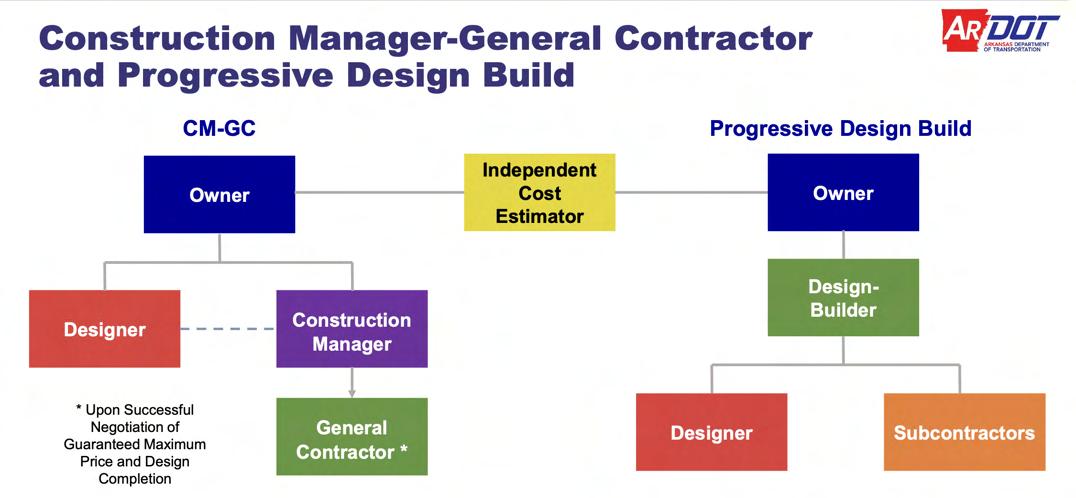
ARDOT has three different Alternative Delivery Methods in its toolbox, including Design-Build, Progressive Design-Build (PDB), and Construction Manager-General Contractor (CM/GC).
PDB and CM/GC require early contractor involvement, but the PDB method relies on a collaborative team from the project’s onset. In contrast, the CM/GC relies on a construction manager to oversee the design and construction and serves as the general constructor. According to ARDOT, “Independent Cost Estimating” is critical to the ADM process, and establishes a Guaranteed Maximum Price. This provides customers, such as ARDOT, with cost certainty and transparency. Wylie said, “Only on projects where the method fits best. Design Bid Build will always be the main project delivery method at ARDOT but it’s nice to have the tool in our toolbox if the right project is identified.”
Guy Washburn, PE, General Manager for Cranford Construction Co., who has 20-plus years in highway construction, said his North Little Rock-based company was a subcontractor on 30 Crossing.
Washburn said Kiewit-Massman Construction “is a leader in this type of project delivery system. Their management of the project was so effective.”
Washburn noted that unlike many other projects he has been involved with, “It wasn’t ego-driven, it was not about the individual but everyone worked together. They emphasized good communication throughout the process and structured pre-planned meetings from start to finish.”
Washburn added, “I believe this type of Alternative Delivery system will be the gold standard going forward.”
In addition to 30 Crossing, the department has several other projects that fall under ADM. Delta 77 in West Memphis, which is reconstructing the I-40, I-55, and Highway 77 interchange, is a Progressive DesignBuild project. Wylie said, “We just executed our first work package for that project. The other portions of it are in the pre-construction phase.”
Also, five Construction Manager-General Contractor projects are either completed or underway around the state. These are Ark. Hwy. 10 at I-430 in Little Rock, now completed; U.S. Hwy. 62 at I-49 in Fayetteville, under construction; and the pre-construction projects include U.S. Hwy. 65B in Conway; Ark. Hwy. 1 in Jonesboro; and Ark. Hwy. 5 between Ark. Hwy 183 and the Pulaski and Saline County line near the Alexander and Bryant areas.
Good Roads Executive Director Joe Quinn says the completion of the 30 Crossing project was historic in several ways: “Two of the most important things that have happened in the Arkansas infrastructure world in recent years have been the ARDOT effort to consider different approaches to work and to get contractors in the dialog earlier. The way 30 Crossing was completed on budget and ahead of schedule is a reminder that ARDOT and the road construction industry are working to maximize technology, workforce availability, and budgets to accomplish great work. It’s pretty clear right now that ADM and Design Build are working.”


















Jones has a bachelor’s degree in civil engineering from Arkansas State University at Jonesboro and a master’s degree in civil engineering from the University of Arkansas at Fayetteville.
She is a Registered Professional Engineer. Jones began her career with the Department in January 2002 as a Civil Engineer in the Bridge Division. In December 2002, Jones transferred to the Planning and Research Division to participate in the Transportation

Research Assistantship Program at the University of Arkansas.
Upon completion of a master’s degree through the Assistantship Program, Jones was reassigned to the Bridge Division. Following an engineering career path, Jones advanced through several positions before becoming Consultant Coordinator in October 2008. Jones promoted to Assistant Division Head of Transportation Planning and Policy (now Planning and Research) in February 2011 and then to Division Head in October 2013. She transferred to the Program Management Division as Division Head in March 2020, and assumed her current position of Assistant Chief Engineer – Planning in April 2023.
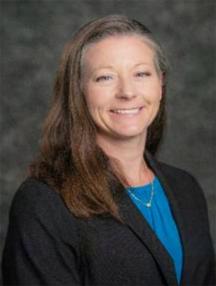
Adams has a bachelor’s degree in civil engineering from the University of Arkansas at Fayetteville. She is a Registered Professional Engineer. Adams began her career with the Department as an Engineering Intern prior to being hired in August 2002 as a Civil Engineer in Roadway Design. In February 2003, she transferred to the Program Management Division where she continued to advance along the civil engineering career path.
Adams promoted to Assistant Division Head of the Program Management Division in May 2021 and then to her current position of Division Head in May 2023.





CAPE GIRARDEAU, M.O. - Delta Companies Inc. (Delta), a Colas company and subsidiary of Reeves Construction Company (Reeves), has completed a rebranding effort in response to accelerating company growth and streamlining the operations of its multiple sub-brands.
Delta is a leading, vertically integrated transportation construction company in the Missouri-Arkansas region, with numerous aggregate locations, asphalt plants, a liquid asphalt terminal, an emulsions plant, and multiple local construction offices.
Over the past 7 months, Delta Companies and its regional divisions have renewed a united corporate vision and created a new brand identity under the name: Delta.
Speaking about the impact of the rebrand, Brad Marotti, Vice-President of the Delta Division of Reeves, shared, “The Delta team is very excited about everything we have accomplished and the trajectory of the company. The dedication of our employees, the trusted relationships we’ve built over 100 years, and the global strength of COLAS, all combine to make Delta a force in the construction industry across southeast Missouri and northeast Arkansas. We believe that this rebrand will better convey the future vision of Delta and set us up for success in 2025 and beyond.”
The bold new company logo design is a visual spinoff of the Reeves corporate logo, and delivers a modern take on traffic movement and pavement lines running parallel, forming pathways, and connecting communities and people.
Zach Green, President of Reeves, said, “Delta’s new company brand honors our long-standing legacy in the region, and also encapsulates feedback from our Delta team - the real people doing the hard work on the ground. We look forward to rolling out the rebrand across Delta locations and our fleet in the next few months.
Our dedicated employees were integral in the rebranding process, and the new brand launching
today represents their spirit of accomplishment, dedication and service.”
To learn more about Delta and explore its products and services, please visit www.deltacos.com.
Delta Companies Inc. is a highway and site development contractor specializing in asphalt paving and road construction materials across the greater Missouri-Arkansas region. Delta is a division of Reeves Construction Company and a member of the COLAS family of global companies. Delta performs a wide range of infrastructure and transportation work, including asphalt paving; aggregate base construction; site development; airport construction; grading; and drainage. Learn more at www.deltacos.com.

Matt Crafton, P.E., President and CEO of Crafton Tull, was named a Fellow of the American Council of Engineering Companies (ACEC) and recognized at the 2024 ACEC National Fall Conference in New Orleans.
“We are so proud of Matt and his contributions to ACEC Arkansas and the engineering industry as a whole. He’s been instrumental in growing our association and educating our youth about the opportunities in the engineering industry,” said Angie Cooper, ACEC Arkansas Executive Director. “We are thrilled to recognize and honor Matt as our newest ACEC Fellow in Arkansas.”
Being an ACEC Fellow is a prestigious distinction showing Matt’s outstanding contributions to the engineering profession. This honor is a lifetime
distinction reserved for individuals who have made significant contributions not only to their companies, but also to the engineering industry.
“I’m incredibly humbled and grateful to our ACEC Arkansas board of directors and other industry colleagues in the state who nominated me for this recognition,” Crafton said. “I’m also thankful for Crafton Tull’s support of my service in this great organization. ACEC is truly the voice of the engineering industry, and our firm is very proud to support its mission.”
Matt started his career as a civil engineer in the U.S. Air Force, where he managed the design and construction of many projects for Air Force missions around the world.
He has led Crafton Tull as CEO for more than 15 years, guiding the company through significant growth and success. Today, Matt oversees the operations of Crafton Tull’s nine offices and provides quality control on a variety of engineering projects.

The U.S. Department of Transportation (USDOT) has awarded a $24.9 million Rebuilding American Infrastructure with Sustainability and Equity (RAISE) grant to the Arkansas Department of Transportation (ARDOT).
The funding provided by this RAISE grant will be used toward the construction of a 4-mile highway that bypasses U.S. Highway 67 around the west side of Corning. The Corning Bypass is part of a larger, multi-state effort to complete Future Interstate 57 between Walnut Ridge and Poplar Bluff, Missouri.
“When complete, the Interstate 57 Corridor will improve mobility and enhance economic development for our state and the region,” ARDOT Director Jared D. Wiley said.
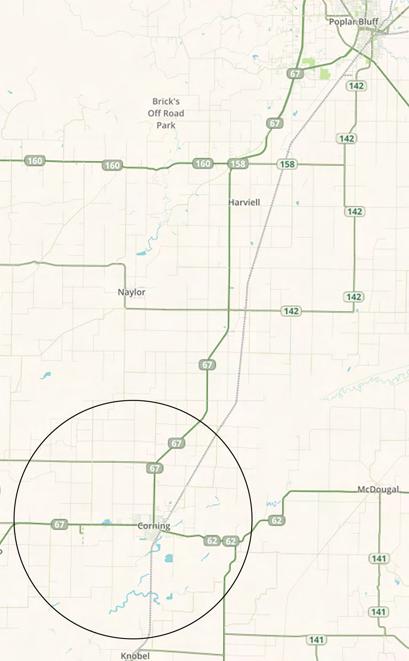
The Corning Bypass will be a four-lane, fully controlled access facility that will include two interchanges with U. S. Highway 67. The project will provide an alternate route for commercial trucks around Corning’s downtown business district and will improve safety and quality of life for residents.
“This transportation grant funding will be used to assist ARDOT as we work to complete the missing link in the transportation network that will ultimately connect the Little Rock metropolitan area with Chicago via an Interstate highway,” Wiley said.
The RAISE program is one of several competitive grant programs providing funding to communities across the country. During this funding cycle, the USDOT awarded $1.32 billion in grant funding for
more than 109 projects across the country.
“I am grateful to Senator Boozman and Congressman Crawford for their support of this project,” Wiley said.
“Through their efforts, Arkansas has received an additional $17.4 million in Congressionally Directed Funding specifically for Interstate 57, bringing the total amount of additional funding to $42.3 million for this project.”
Five other Arkansas recipients were awarded RAISE grants during this funding cycle. Rock Region Metropolitan Transit Authority received $5.4 million to design a replacement of their transit station. The City of Fort Smith received nearly $25 million to construct 9.3 miles of active transportation facilities. Northwest Arkansas Regional Planning Commission received $25 million to construct side paths along 17.5-miles of Highway 112 in connection with upcoming ARDOT projects to improve the corridor.
The City of Mena received $3.3 million to create an active transportation plan, master street plan, ADA transition plan, and a complete streets policy. The City of Hot Springs received $2.3 million to plan four new multi-use trails.
“Our staff worked hard to develop a strong grant application, and I am proud to see that their labor is bearing great fruit,” Wiley said. “We appreciate the United States Department of Transportation’s recognition of the national importance of the Interstate 57 Corridor.”
Visit the USDOT website to read more about the RAISE Grant process.



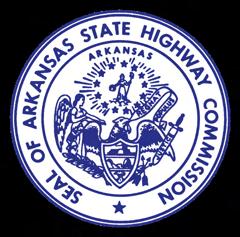



Governor Sarah Huckabee Sanders today announced that she has appointed Jerry Halsey to the Arkansas State Highway Commission. His term expires January 14, 2035. He is replacing Alec Farmer.
“Jerry is an incredibly gifted businessman, a leader in Jonesboro, and most importantly, a great friend. I know his experience in community development in Northeast Arkansas will lend itself to his new role on the Highway Commission and I look forward to working with him to keep Arkansas the center of America’s road, river, and rail systems,” said Governor Sanders.
“I thank Governor Sanders for this opportunity to serve, and for her trust and confidence in me. I am excited and ready to go to work,” said Jerry Halsey.
Brief Bio:
Jerry L. Halsey, Jr. is the founder, CEO and President of Halsey Thrasher Harpole Real Estate Group, with offices in Jonesboro and Benton.
Jerry is a graduate of Arkansas State University. He sold real estate through his college career, farmed with his father for a time, and then expanded the family business into real estate.
Jerry holds a real estate license in multiple states and qualifies for designations based on training and experience. He currently serves as a member of the Arkansas Highway Commission, Vice-Chair of the Arkansas Real Estate Commission and a member of the Board of Directors for the Arkansas State Police Foundation.
Jerry previously was inducted into the Northeast Arkansas Board of Realtors Hall of Fame, and he served as a Commissioner for the Arkansas Building Authority, Chairman of the Jonesboro Metropolitan Area Planning Commission, a member of the Jonesboro Vision 2030 comprehensive planning advisory commission, SIOR President for the Arkansas Chapter, and President of the Board of Directors for City Youth Ministries.
Jerry and his wife, Cheri, have two daughters. Taylor and her husband, Landon Wilson, work with Jerry and Cheri in the family real estate business. Olivia is finishing law school and working with Governor Sanders’ legal department. The Halseys are members of Southwest Church of Christ in Jonesboro.

$10,000 and Over



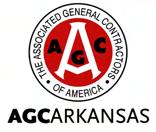


$5,000 and Over



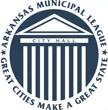



$2,500 and Over

ACEC/A & ASPE
American Concrete
Pavement Assoc. OK/AR
APAC-Tennessee
The Cashion Company
CPC Midsouth
APAC-Central
Arkadelphia Alliance
Arkansas Concrete
Arkansas Farm Bureau
Ash Grove Cement
Bank of Delight
Bob Crafton
Clark Machinery
Commercial Bank - Monticello
Contractor’s Specialty Service Co.
Cowling Title
Curt Green & Co.
Dermott Industrial Dev.





$1,000 and Over
D.B. Hill, III
Emery Sapp & Sons
First Community Bank of Batesville
Golden Triangle Economic Development
Duffield Gravel Company
Jeffrey Sand Company
Jim Wooten
McGeorge Contracting Co.
Michael Baker International
Natural State Consulting and Strategies
$500 and Over
Dumas Chamber of Commerce
Eagle Bank and Trust
Fayetteville Chamber of Comm.
FM Structural Plastic Technology
Forsgren, Inc.
Harold Beaver
Hines Trucking Inc.
Horatio State Bank
I-49 International Coalition
Jack Buffington
Jensen Construction Co.
Jerry Holder
JoAnne Bush
Jonesboro Chamber of Comm.
LaCroix Optical Company
Larco, Inc.
Lawrence Co. Chamber of Comm.
M & T Paving and Construction
Maxwell Hardwood Flooring
Midwest Lime Company
Mobley General Contractors
Monticello Econ. Dev. Comm.
NEA Intermodal


NWA Council
Riceland Foods
Rogers Group
Walmart
Ohlendorf Investment Co.
Paragould Regional Chamber
Philip Taldo
Pickering Firm
Razorback Concrete
Robert Moery
Ryburn Motor Company
Scott Equipment
SN Contractors
Springdale Chamber of Comm.
SW AR Plan & Dev. District
UCA Foundation
Western AR Intermodal
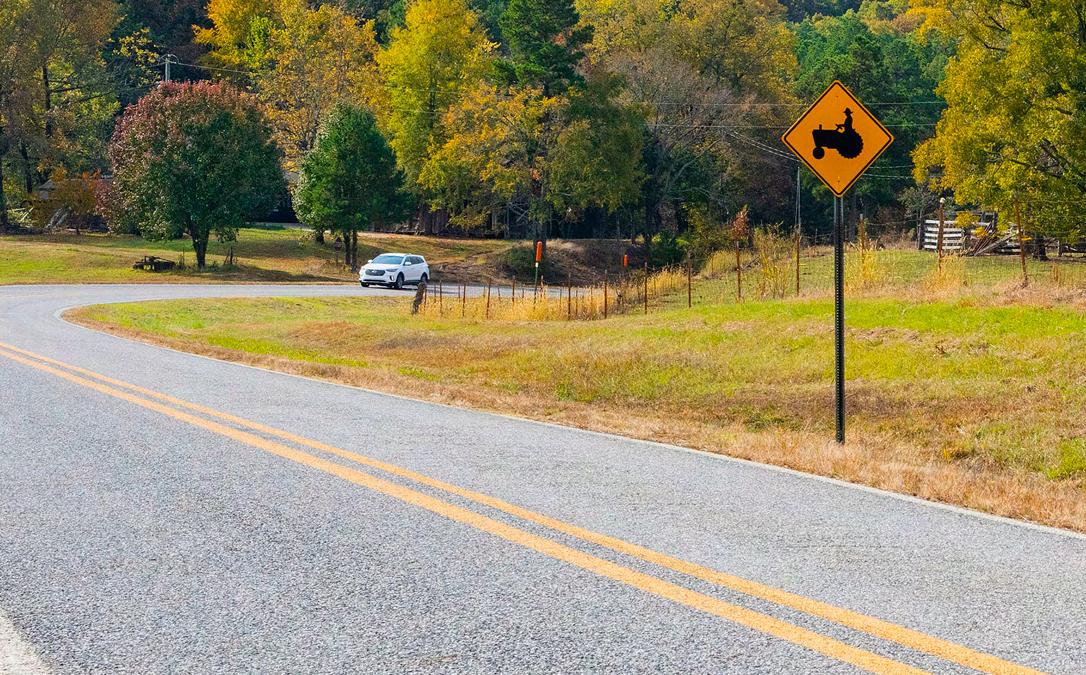
Good Roads works with our members to tell the story of the need for funding and financing to help all communities develop, build and maintain roads and bridges. This drives the local economy and makes the roads safer for all of us. We have corporate and individual membership rates available. The award-winning Good Roads magazine reaches more than 1,200 key stakeholders. If you want to put your message in front of an elite audience of state legislators, mayors, county judges, Good Roads members, engineers and the companies that build roads and bridges, this is the best way to do it. This is the only in-state publication that offers you an easy way to reach this very specific audience.



As a Garver Bridge Team Leader, Jessica Halbrook, PE, builds the bridges –both literal and figurative – that keep Arkansans connected. Her engineering team evaluates the region’s bridges, keeping them safe for local and out-of-state travelers.

Jessica Halbrook, PE Bridge Team Leader
Arkansas Good Roads Foundation

Roads are literal and metaphorical connectors. They provide essential delivery of our daily needs – they also lead us to the things that matter most. As Americans, we depend on them for our safety and for our livelihoods. At Ergon, we are proud to work in communities across America helping build and maintain vital infrastructure that connects us all to what matters most.